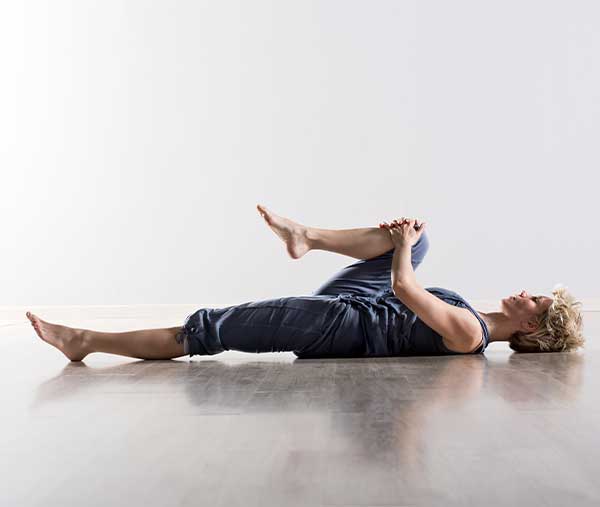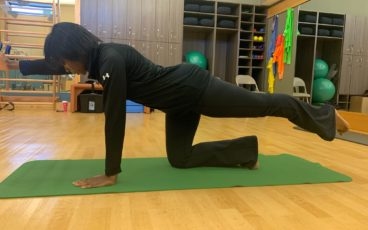If you often suffer from a shooting pain or tingling sensation down your leg, you may be one of the many people struggling to find sciatica pain relief. For some people, sciatica can be a mild annoyance; for others, it can be a debilitating pain that makes it hard to walk or even stand.
According to Harvard Health, sciatica is one of the most common yet misunderstood types of pain. As many as 40% of people will be affected by it at some point in their life.
This article will cover the symptoms and causes of sciatica and share some proven tips for relieving pain, including gentle yoga poses and remedies you can try at home.
What Does Sciatica Pain Feel Like?
Sciatica pain (often referred to as “radiculopathy” by your spine specialist) is caused by the irritation, inflammation, pinching, or compression of a nerve in the low back. The most common cause is a herniated disc that puts pressure on the nerve root.
The sciatic nerve is the longest nerve in your body and runs from your lower back through your buttocks and down the side of your leg. It is formed by the joining of multiple individual nerves originating in the lumbar spine (low back). So even though you may primarily feel the pain in your leg, it’s originating from your back.
Symptoms of sciatica vary from person to person, but the most common ways people describe it include:
- Pains on One Side of the Buttocks and Leg
- Sharp or Stabbing Pains
- Tingling Sensations or Numbness
- Burning or “Electric” Sensations
Sciatica pain may be constant, or it can come and go. The pain may increase when sitting or standing for long periods. A sudden body movement or twist can also increase your pain.
What Causes Sciatica?
There are several different causes of sciatica pain. Two of the most common include:
- Spinal Stenosis
- Injury
Spinal Stenosis
Spinal stenosis is a narrowing of the spinal canal that happens as you age. This can be due to thickened ligaments, bone spurs, osteoarthritis, or tumors. As the nerves that form the sciatic nerve travel through that narrow space, it gets compressed, causing sciatica.
Injury
Problems with your sciatic nerve can also develop after you’ve experienced trauma to your lower back. Examples of incidents that can cause serious injuries include car accidents, bad falls, and contact sports.
Sciatica Pain Relief Tips
In many cases, sciatic symptoms will appear suddenly, last a few days or weeks, then resolve on their own with conservative treatments.
If your symptoms are mild or sciatica is in its early stages, rest may be all you need to recover. But there are some other things you can try that may provide sciatica pain relief.
1. Improve Your Posture
Good posture can benefit your spine health, and just a few minor tweaks can sometimes provide significant sciatica pain relief. Be mindful of your posture and make the following adjustments as needed throughout the day.
To realign your spine while sitting:
- Avoid a hunched-over position which can reverse your spine’s natural curves
- Sit upright as far back in your chair as possible
- Plant both feet flat on the floor, with your chin parallel to the floor
- Relax your shoulders
- Use a rolled-up towel or lumbar pillow to support your lower back curve if needed
To improve your posture while standing:
- Avoid slouching with your head forward, which disrupts the alignment of your spine
- Hold your head straight with your ears level
- Make sure your shoulders are even, and your hips are level
- Relax your knees and point them both straight-ahead
- Wear comfortable shoes that offer good support
2. Use Hot and Cold Therapy
Hot and cold therapy can provide sciatica pain relief by decreasing inflammation (ice) and relaxing your muscles (heat).
Apply an ice pack to your lower back for 20 minutes and repeat every two hours. You can alternate between heat and ice or try one to see what gives you the most sciatica pain relief.
3. Try Over-the-Counter Medications
Nonsteroidal anti-inflammatory drugs (NSAIDs) and other pain relievers can help with the inflammation and pain associated with sciatica.
These medications are widely available and don’t require a prescription:
- Ibuprofen (Advil, Motrin)
- Naproxen (Aleve)
- Acetaminophen (Tylenol)
4. Treat Yourself to a Massage
Some people find that getting a deep and firm massage can help soothe cramped muscles and relax nerves and ligaments. Massage therapy uses techniques aimed at releasing tension in muscles and reducing inflammation.
If you plan to try massage for sciatica pain relief, look for an experienced and reputable massage therapist familiar with sciatica pain and who knows the right areas to focus on.
Acupuncture and dry needling are wellness services that can alleviate sciatica pain for some patients. Like massage, these are also offered at HPI.
5. Exercise and Stretch
It might seem counterintuitive to exercise when you’re having back pain, but it can actually help provide sciatica pain relief in many cases.
Low-impact aerobic exercises like walking and swimming can strengthen your muscles and release natural pain-relieving endorphins into your body. Lightweight strength training can help create proper alignment in your lower back, gluteal, and thigh muscles. Pilates, also offered by HPI’s certified instructors, increases flexibility which can provide lower back pain relief.
Different exercises and stretches will work better for different people. An experienced physical therapist can help develop a customized plan for you.
Yoga Poses for Sciatica
Seeing an experienced yogi doing a handstand or contorting their body like a pretzel can make yoga seem intimidating. But there are several gentle yoga poses that people of all fitness levels can do, and some may provide sciatica pain relief.

1. Standing Hamstring Stretch
This yoga pose can ease pain and tightness in the hamstrings often associated with sciatica. To do this pose:
- Place your right foot up on a chair or step with your leg straightened and your foot flexed (you can slightly bend your knee if needed).
- Bend forward slightly toward your extended foot (stretch only as far as you feel comfortable).
- Hold for 30 seconds, then repeat with the other leg.
2. Sitting Pigeon Pose

This pose can provide sciatica pain relief by stretching the glutes and lower back. To do this pose:
- Sit on the floor with your legs stretched out in front of you.
- Bend your right leg and place your right ankle on top of your left knee.
- Lean forward and stretch toward your thigh.
- Hold for 15 to 30 seconds.
- Repeat on the other side.
3. Reclining Pigeon Pose

The reclining pigeon pose helps stretch the piriformis muscle, which can sometimes press on the sciatic nerve. It also stretches the hip rotator muscles. To do this pose:
- Lay down on your back and bring your right leg up to make a right angle.
- Clasp your hands together behind your thigh.
- Lift your left leg and place your right ankle on top of the left knee.
- Hold the position for 15 to 30 seconds.
- Repeat on the other side.
4. Knee to the Opposite Shoulder

This stretch provides sciatica pain relief by loosening your gluteal and piriformis muscles. To do this pose:
- Lie on your back with your legs extended out and feet flexed.
- Bend your right leg and clasp your hands around your knee.
- Gently pull your right leg across your body toward your left shoulder (only pull your knee as far as it will comfortably go).
- Hold for 30 seconds, then release your leg down.
- Repeat for three reps, then switch to the other side.
5. Groin and Long Adductor Muscle Stretch

This gentle stretch releases tension in your muscles and eases pressure on the sciatic nerve. To do this pose:
- Sit down on the floor with your legs straight and spread apart (as far apart as is comfortable for you).
- Place your hands out on the floor in front of you.
- Lean forward and place your elbows on the floor (if you can).
- Hold the position for 10 to 20 seconds.
FAQs About Sciatica Pain Relief
To learn more about onset and causes, look at these frequently asked questions on the topic.
How Long Does Sciatica Take to Develop?
Depending on its underlying cause, sciatica can come on suddenly or develop gradually over time. For example, a herniated disc can cause sudden pain, while arthritis develops slowly.
What Are the Risk Factors for Sciatica?
A herniated disc is the most common direct cause of sciatica. Your age, activity level, and injuries are risk factors for disc herniation.
Other risk factors for sciatica include:
- Obesity
- Jobs that Require Heavy Lifting
- Sedentary Lifestyles
- Arthritis
- Previous Spine Injuries
- Pregnancy
- Genetic Factors
Does Pregnancy Weight Gain Cause Sciatica?
To help prepare a woman’s body for childbirth, the hormone relaxin increases during pregnancy. This hormone relaxes the ligaments, and as they loosen, the sciatic nerve can shift and get pinched. The baby’s weight can also put extra pressure on the mother’s sciatic nerve, causing pain.
Fortunately, most pregnant women feel sciatica pain relief once their baby is born.
When to Visit a Doctor for Sciatica
If you’ve had even mild sciatic nerve pain for more than a month, it’s essential to see a back specialist to assess your condition and discuss the next steps for treatment.
Physical therapy can also help provide sciatica pain relief. Trained physical therapists combine an understanding of alignment, movement, and therapeutic exercise to develop a customized care plan and help you reach realistic goals.
Additionally, if you experience any of the following more severe symptoms, see a doctor right away:
- Severe leg pain or lower back pain
- Sudden weakness, numbness, tingling, or electric shock-like pain
- Pain that doesn’t improve after two weeks
- Pain that gets worse, even when using at-home remedies
- You lose control of your bowels or bladder
Get Sciatica Pain Relief at IBJI
IBJI’s experienced and highly-trained orthopedic doctors and physical therapists are very familiar with managing pain and treating many conditions, including sciatica. Their primary concern is getting you the sciatica pain relief you deserve.
If you think you may be suffering from sciatica, Schedule online with our pain management experts.


.jpg)


